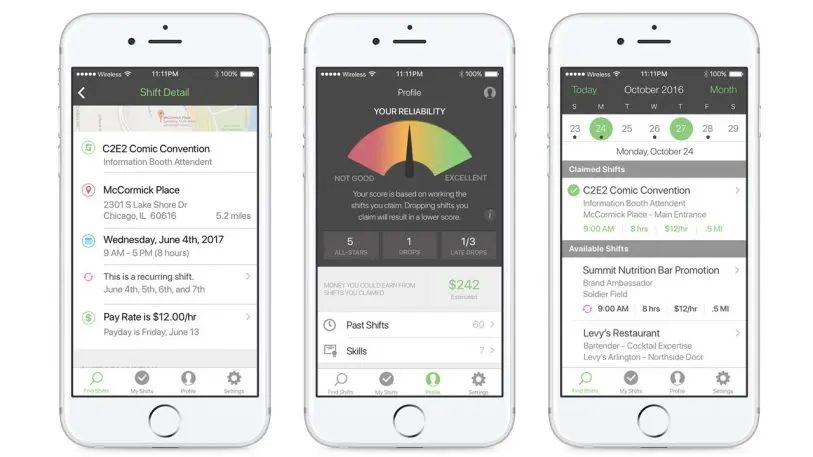Whatever your views on the benefits or harmful consequences of the gig economy, one thing is clear: It just keeps growing. There are an estimated 44 million people employed in such gigs, representing around 29% of the total workforce in the U.S. Many of these people have full-time jobs and take on extra gigs to supplement their incomes, a new reality in an age of wage stagnation. Many of these gigs are filled by staffing firm startups that claim to disrupt the traditional staffing status quo with an app and make grabbing a shift or filling a last-minute job easier than ever.

For blue collar jobs like warehouse stocking, bartending, or working retail, there are BlueCrew, Wonolo, and Shiftgig vying for your attention. Eddie Lou, the executive chairman and cofounder of the biggest of the three by revenue, Shiftgig, sees smartphones as the force that helps the gig economy prosper and companies like his to exist. “The biggest driver is smartphones because now everyone has access to information with a click of a finger at their hands all the time,” explains Lou. Even 10 years ago, most people had to go home to get on the internet, Lou said.

Another driver of the gig economy is the instability of the job market. The idea that an employee will work for one company for their entire career “is nearly gone the way of the dinosaur,” said Wade Burgess, who starts his own new gig, as the CEO of Shiftgig on September 25 after nearly a decade at LinkedIn. Burgess sees Shiftgig, which he describes as “a technology company that happens to be in the staffing space,” as filling a similar role to LinkedIn —”reducing the complexity of talent and opportunity meeting.”
While traditional staffing agencies still mostly focus on staffing up for a period of time with advance warning, hybrid technology and staffing companies like Shiftgig use an app to offer clients the ability to grab workers to fill last-minute shifts, which the workers can browse and claim on their smartphones anytime.
Shiftgig contracts with major employers in the hospitality, retail, experiential marketing, and e-commerce distribution and logistics space, providing vetted employees that can take last-minute shifts when, for example, a bartender at a hotel calls in sick or a warehouse finds itself unusually busy. To avoid any potential pay disputes down the road, Shiftgig pays its shift employees directly for their work, instead of having clients pay individual workers. Much like a traditional staffing firm, the company vets its shift workers, 85% of whom they classify as W2 employees, to the same standards that the clients where they would pick up shifts would demand of full-time staff. Both shift workers and clients are able to rate each other through the Shiftgig app, providing an added metric for factors like reliability. So far, that model has allowed the company to raise $59 million in funding, and grow its presence to all 50 states, though shifts are currently mostly focused on 12 major cities, concentrating around larger employers.
Eric Sconyers is a brand ambassador in Shiftgig‘s home city of Chicago. With his booming and friendly voice and energetic manner, it’s easy to see why he would be a good fit for the job. An actor and director by day, he says he picks up one or two shifts a week to supplement his income. “In the morning, I see if anything is going on, also in the middle of the day some stuff pops up, I keep an eye out and I get push notification and claim it right there,” he says.
Because he was already working as a brand ambassador when he signed up with Shiftgig, it was relatively simple for him to start picking up shifts in that role quickly. When his acting bookings are slim and auditions are few, he signs up for five shifts a week, but most weeks he only picks up one or two shifts, making him one of the company’s 1099 employees.
While the age range of people using the Shiftgig app runs the spectrum from 18-year-olds to senior citizens, when it comes to gender, an overwhelming majority, 68%, are women. Lou speculates that a large percentage of the men who would want to pick up low-skilled shifts are already doing so at gig economy startups that provide driving jobs, like Uber and Lyft, which women tend to avoid for safety reasons. Bartending in a sports stadium with 60,000 people tends to feel a lot safer than getting into a car with one person, Lou points out.

A reflection of the economic times, around 70% of Shiftgig‘s employees have another job and use the app to pick up extra work to supplement their incomes. Despite Shiftgig’s focus on low-skilled labor, 66% of the people using its app to find shifts have some kind of degree above the high school level, a stark reality at a time when a degree no longer guarantees a high-paying job.
Though countless articles tout the death knell of full-time employment as a lifestyle and sing the praises of freelancing work, according to Staffing Industry Analysts’ survey of U.S. workers, 78% preferred traditional full-time employment over working gigs. Shiftgig does not keep numbers on how many of its employees get full-time work at the places where they pick up shifts, though it does happen often enough that Lou sees it as another avenue for the company to grow.
“We allow businesses to test someone before they hire someone full-time,” he points out. In the future, Shiftgig hopes to create a mobile app for workers looking to find full-time work and change careers as well as providing career coaching, though don’t expect the company to hire human resources staff to facilitate the service. “In a staffing agency it is someone’s brain; at Shiftgig, it is technology,” explains Lou.
While companies like Shiftgig and competitors BlueCrew and Wonolo receive a lot of attention in the press, they are still just a drop in the bucket relative to traditional staffing firms. David Francis, a senior research analyst at Staffing Industry Analysts, estimates that revenues for traditional staffing firms in the blue-collar space totaled around $33.5 billion in 2016 for the U.S. Meanwhile, revenues for all the technology-enabled staffing startups in the same space, including those in Europe, taken together, represent an estimated $100 million total for 2016.
Large clients like an Amazon or Walmart typically work with several suppliers at the same time for their staffing needs, making it possible for startups like Shiftgig to work alongside traditional staffing firms. Though they represent a small part of the staffing market, technology-enabled firms like Shiftgig are getting noticed by legacy staffing firms, Francis said. Traditional staffing firms have historically not been technology-driven, explains Francis, but that does not mean that the giants in the staffing industry will not eventually catch up on technology, which could in theory make all the app-based startups obsolete. But Lou is not worried. His staffing technology can be used as a platform by traditional staffing firms, he explained, and he is already partnering with a few firms. And it is not just staffing, points out Burgess; there are all the other players in what the CEO calls “human capital management,” like payroll and benefits departments, that could use a technology boost from the right partner.
Recognize your brand’s excellence by applying to this year’s Brands That Matter Awards before the early-rate deadline, May 3.
